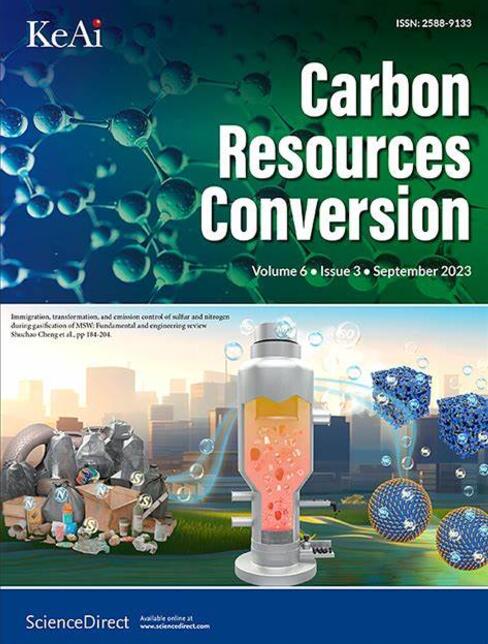Co-digestion of filter cake, biogas effluent, and anaerobic sludge for hydrogen and methane production: Optimizing energy recovery through two-stage anaerobic digestion
IF 7.5
3区 环境科学与生态学
Q2 ENERGY & FUELS
引用次数: 0
Abstract
This study assesses a two-stage anaerobic digestion process designed to efficiently recover energy through hydrogen and methane production by co-digesting filter cake (FC), biogas effluent (BE), and anaerobic sludge (AS) from the sugar and ethanol industry. The optimal proportions of FC, BE, and AS were determined in batch fermentation experiments using Design Expert software, which identified a suitable ratio of 31.05:28.95:0.00 (g VS/L), respectively. The results indicated that hydrogen production in the first stage could occur solely through the hydrogenic bacteria present in the BE and FC mixture, without the need for AS as an inoculum. This optimized FC:BE ratio was then applied in a semi-continuous fermentation system, achieving a hydrogen production rate of 193.6 mL H2/L.d and a hydrogen yield of 9.8 mL H2/g VS at an optimal hydraulic retention time (HRT) of 3 d. In the subsequent second stage, the effluent from the hydrogen reactor was used for methane production. This stage achieved a methane production rate of 422.0 mL CH4/L·d and a methane yield of 140.2 mL CH4/g VS, with an HRT of 20 d. Overall, the two-stage process exhibited an impressive energy output, peaking at 5.17 kJ/g VS. This suggests the potential for an annual electricity generation of 194,655 MWh and an estimated reduction of 85,668 tCO2eq/year in greenhouse gas emissions. This study highlights the efficiency of the two-stage anaerobic digestion process for harnessing energy through the co-digestion of FC and BE, without the need for additional AS inoculum. The findings demonstrate the potential for sustainable energy recovery from industrial waste streams while mitigating environmental impacts.

协同消化滤饼、沼气废水和厌氧污泥以生产氢气和甲烷:通过两级厌氧消化优化能源回收
本研究评估了一种两阶段厌氧消化工艺,该工艺旨在通过共消化来自糖和乙醇工业的滤饼(FC)、沼气排出物(BE)和厌氧污泥(AS),有效地通过产生氢气和甲烷来回收能量。采用Design Expert软件进行分批发酵实验,确定了FC、BE和AS的最佳配比,确定的最佳配比分别为31.05:28.95:0.00 (g VS/L)。结果表明,第一阶段的产氢可以完全通过BE和FC混合物中存在的产氢细菌进行,而不需要AS作为接种物。然后将优化后的FC:BE比例应用于半连续发酵系统,产氢率为193.6 mL H2/L。d,在最佳水力停留时间(HRT)为3 d的情况下,产氢量为9.8 mL H2/g VS。在随后的第二阶段,氢气反应器的出水用于甲烷生产。这一阶段的甲烷产率为422.0 mL CH4/L·d,甲烷产率为140.2 mL CH4/g VS, HRT为20 d。总的来说,这两阶段的过程表现出了令人印象深刻的能量输出,峰值为5.17 kJ/g VS.这表明年发电量可能达到194,655兆瓦时,温室气体排放量估计减少85,668吨二氧化碳当量/年。这项研究强调了两阶段厌氧消化过程的效率,通过FC和BE的共同消化来利用能量,而不需要额外的AS接种。研究结果表明,在减轻环境影响的同时,从工业废物流中可持续回收能源的潜力。
本文章由计算机程序翻译,如有差异,请以英文原文为准。
求助全文
约1分钟内获得全文
求助全文
来源期刊

Carbon Resources Conversion
Materials Science-Materials Science (miscellaneous)
CiteScore
9.90
自引率
11.70%
发文量
36
审稿时长
10 weeks
期刊介绍:
Carbon Resources Conversion (CRC) publishes fundamental studies and industrial developments regarding relevant technologies aiming for the clean, efficient, value-added, and low-carbon utilization of carbon-containing resources as fuel for energy and as feedstock for materials or chemicals from, for example, fossil fuels, biomass, syngas, CO2, hydrocarbons, and organic wastes via physical, thermal, chemical, biological, and other technical methods. CRC also publishes scientific and engineering studies on resource characterization and pretreatment, carbon material innovation and production, clean technologies related to carbon resource conversion and utilization, and various process-supporting technologies, including on-line or off-line measurement and monitoring, modeling, simulations focused on safe and efficient process operation and control, and process and equipment optimization.
 求助内容:
求助内容: 应助结果提醒方式:
应助结果提醒方式:


